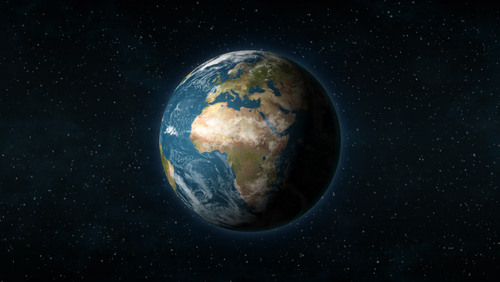NO, THE WORLD WILL NOT END ON APRIL 23
No matter how you interpret the latest cosmic signs, history tells us people don’t have the best track record at predicting the apocalypse
As viral videos and various tabloids tell it, April 23, 2018, will mark the end of an age. Depending on your taste, the date will either bring forth a collision between Earth and a rogue planet or a world-changing celestial alignment that heralds the End of Days.
A word of historical and scientific advice: Don’t cancel your plans for May.
Humans are once again talking about our collective doom thanks to fast-burning “news” trends fanned by Google and the fringe predictions of self-published author David Meade. Last autumn, Meade’s disputed numerology predicted that Earth would encounter a (hypothetical) rogue planet called Nibiru on September 23, 2017.
September 23 came and went without incident, so Meade shifted his prediction to October 2017—and then again adjusted his timetable to November 2017. Now, Meade claims that he has finally ironed out the wrinkles in his vision of the end times. Nibiru (sometimes called Planet X) is supposed to appear in the sky on April 23 and pass by Earth in October, triggering volcanoes of apocalyptic proportions.
SOLAR SYSTEM 101 – How many planets are in the solar system? How did it form in the Milky Way galaxy? Learn facts about the solar system’s genesis, plus its planets, moons, and asteroids.
Meade’s predictions, which don’t enjoy support among mainstream Christians, are the latest spin on the Nibiru conspiracy theory, which has roots dating back to the 1970s. Originally, this planet was supposed to collide with Earth in 2003. However, an uncooperative cosmos forced conspiracy theorists to reschedule for 2012.
Six years later, the rogue planet still poses no threat, because it doesn’t exist.
“Nibiru and other stories about wayward planets are an Internet hoax,” NASA said in a 2012 statement. “If Nibiru or Planet X were real and headed for an encounter with the Earth … astronomers would have been tracking it for at least the past decade, and it would be visible by now to the naked eye.”
THE FAULT IN OUR STARS?
To support his claims, Meade points to an alignment of several planets, the sun and moon, and the constellations Virgo and Leo due to happen in April, which he says will fulfil a prophecy in the Book of Revelations.
Previously, an evangelical Christian publication called Unsealed had argued that the Book of Revelations foretold a similar alignment for September 23, 2017. The publication claimed that the alignment heralded the era leading up to the Rapture, the moment when many Christians believe the devout will vanish from Earth to join Jesus in a new paradise.
The cosmic alignments in question do actually happen. But the significance of the astronomy is debatable. The Biblical sign depends on the number of stars in play, and even astronomers don’t agree how many stars, for instance, officially make up the constellation Leo. Some star charts count nine, while others—including National Geographic’s star atlas—count ten.
For that matter, how unique is the alignment? Again, the details are murky: For a couple of days in September or October every year, the moon passes near its supposedly foretold position.
In an earlier interview, the 2017 alignment didn’t strike Colgate University emeritus professor Anthony Aveni as particularly unusual. Aveni, who specializes in the study of astronomical practices in the ancient world, adds that Virgo wasn’t incorporated into Hebrew astronomy until after the New Testament was written.
But Aveni emphasized that he’s not interested debunking apocalyptic claims. Instead, he wants to understand their cultural roots. For instance, U.S. religious and cultural traditions are steeped with millenarianism, which focuses on prophecies and apocalypses.
According to Aveni, these types of claims also seem to grow out of people getting bored with—and actively resisting—the natural world’s penchant for randomness, opting instead for narrative clarity.
“Everybody wants to know the chemical composition of the burning bush, or where exactly is the Ark of the Covenant … we want the final story, the bottom line,” he said in a previous interview.
TOMORROW, TOMORROW …
Ultimately, all efforts to decode the universe for signs of foretold doom come down to interpretation. And for millennia, humans haven’t shown an accurate knack for it, as National Geographic reported in 2009:
- In 65 A.D., the Roman philosopher Seneca warned that the planet would “burn in [a] universal fire.” While Vesuvius buried Pompeii in lava and ash 14 years later, the end wasn’t exactly nigh for the entire planet.
- Many 17th-century Christian Europeans worried that the world would end in 1666, a year containing the ominous Number of the Beast, described in the Book of Revelation.
- The 1910 arrival of Halley’s comet whipped some citizens of Rome into such a frenzy, they stockpiled oxygen tanks, fearful that the comet’s tail would poison Earth’s atmosphere. (Also find out why Newton believed a comet caused Noah’s flood.)
- On May 5, 2000, the planets Mercury, Venus, Mars, Jupiter, and Saturn aligned in the sky—a conjunction that some authors claimed would bring about earthquakes, volcanoes, and a sudden onslaught of melting ice. It didn’t.
- Since 2008, the Large Hadron Collider has fixated conspiracy theorists with fears that the particle collider would spawn a world-ending black hole. Billions of particle collisions later, the world remains safely uneaten.
- Much ado was made out of December 21, 2012, the end of the Maya long-count calendar—but the frenzy was about nothing. Scholars reject the very idea that the calendar’s end was designed to signal the apocalypse at all.
In sum: Nibiru doesn’t exist, the skies are anyone’s to interpret, and the apocalypse has long been elusive. In all likelihood, we’ll see you on April 24.

